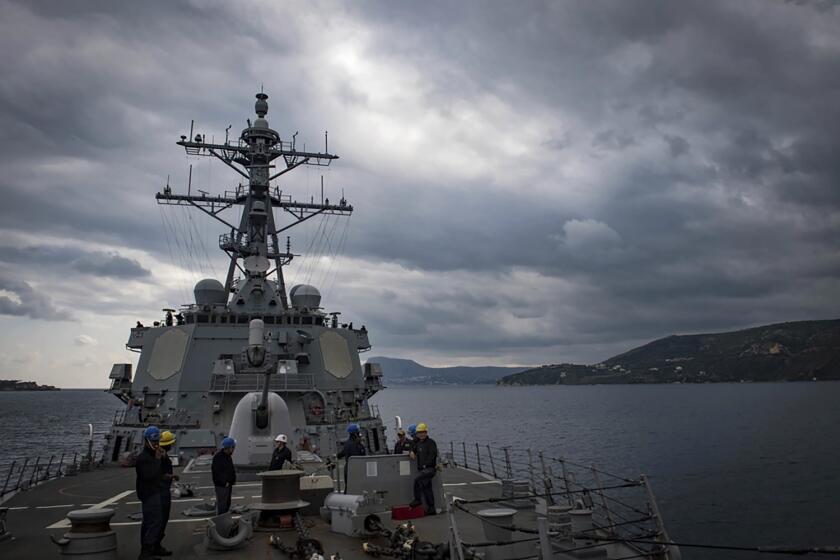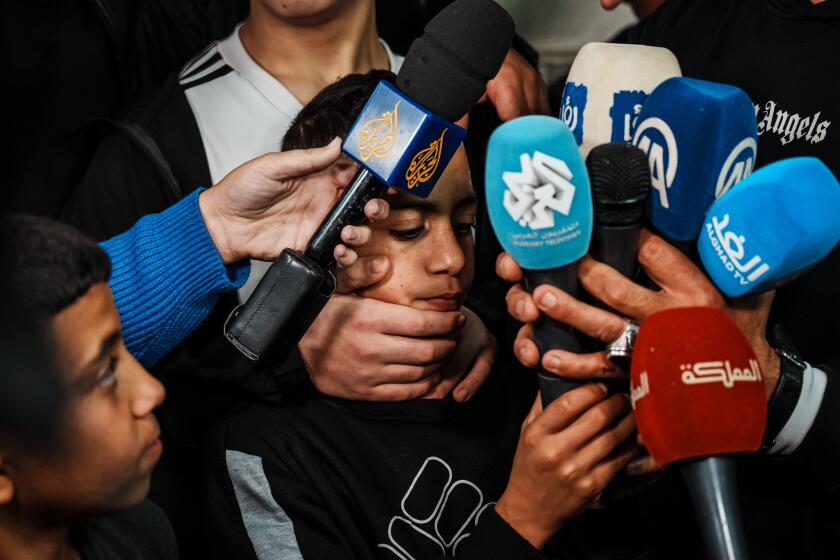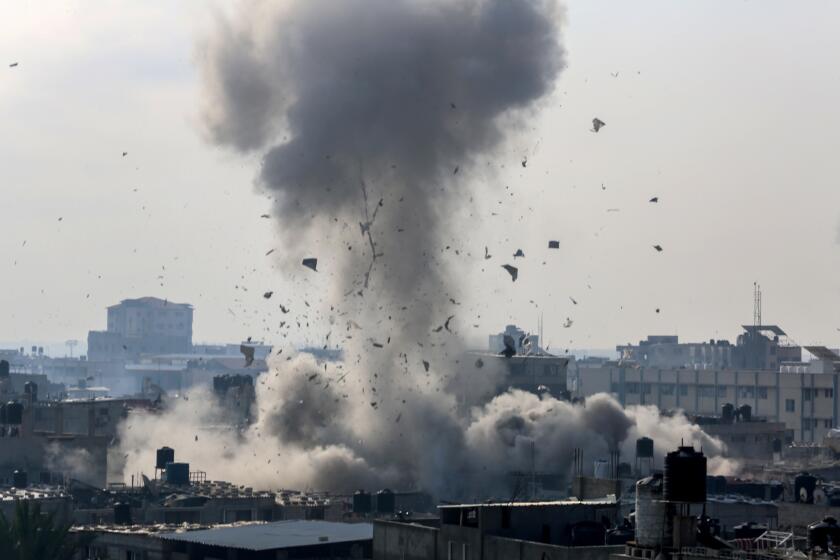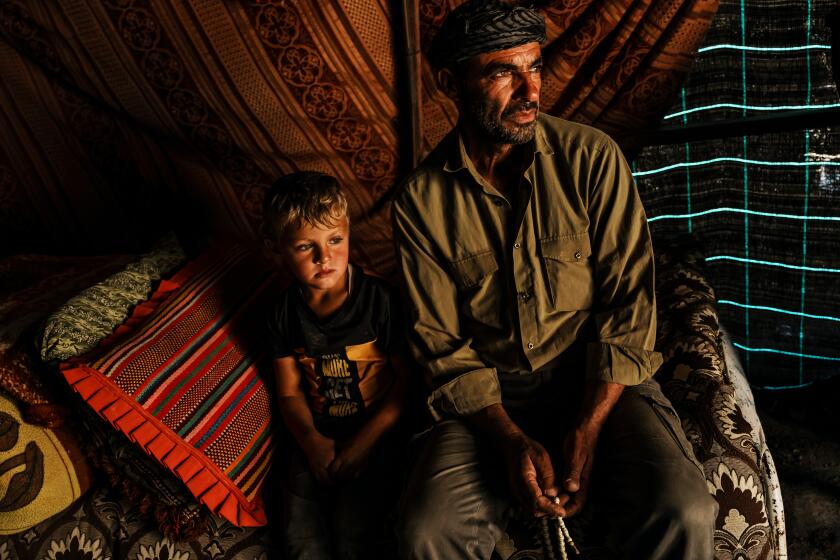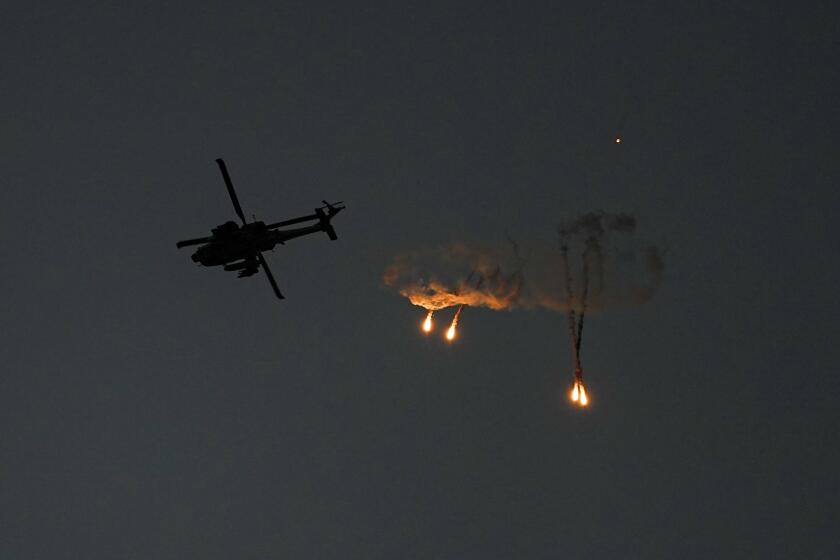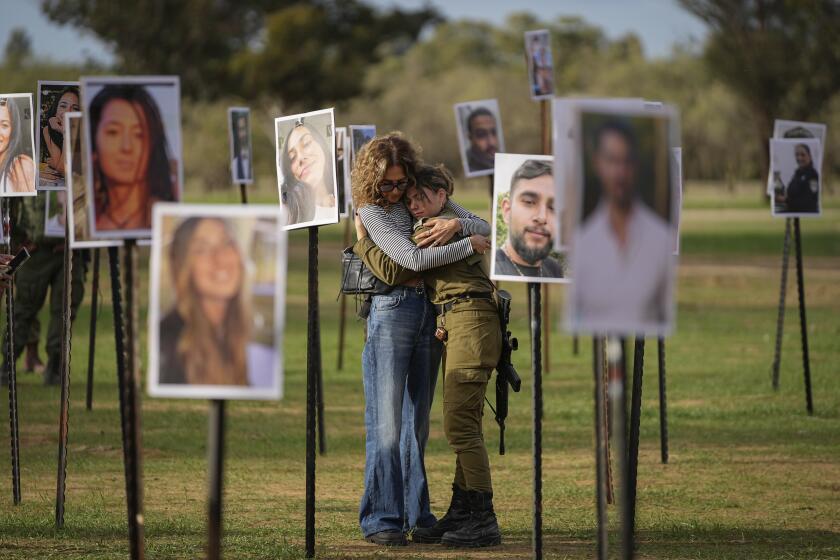Israel expands Gaza ground war, says attacks in south will be ‘no less strength’ than in north
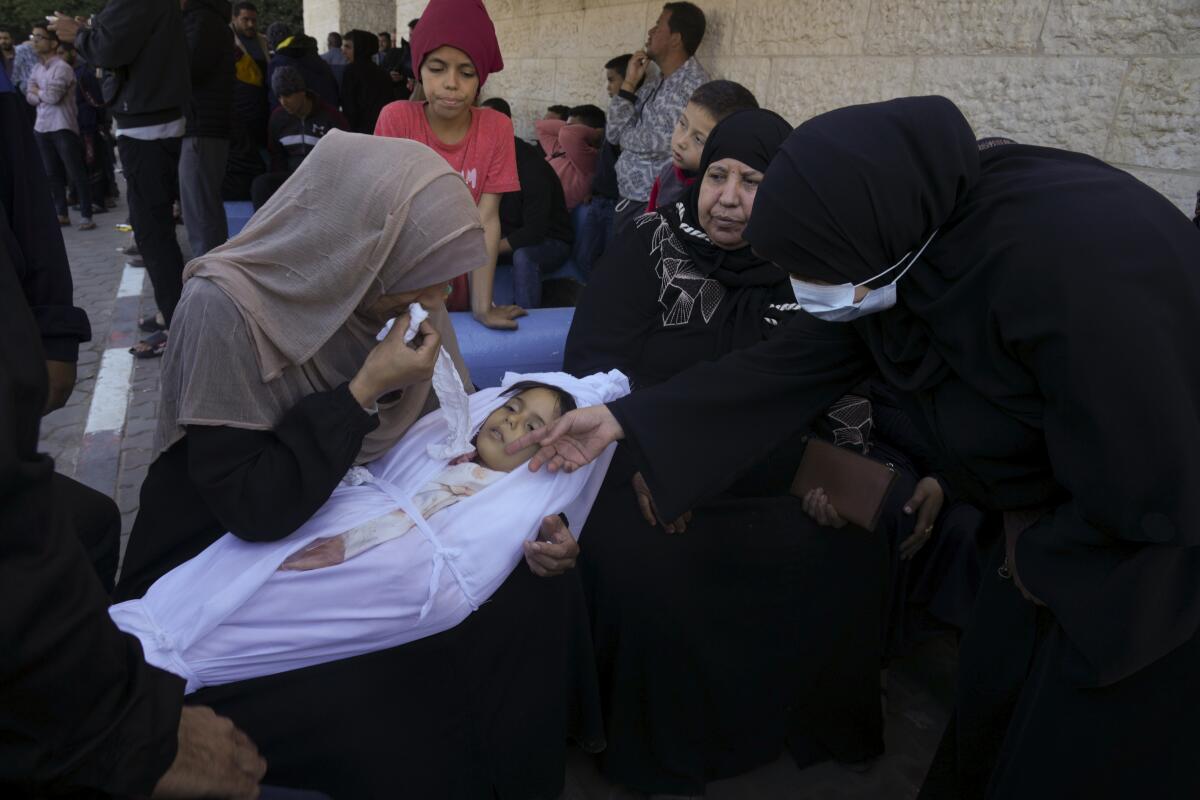
- Share via
KHAN YUNIS, Gaza Strip — The Israeli military said Sunday its ground war had expanded to every part of Gaza, and it ordered more evacuations in the crowded south while vowing that attacks there against the Hamas militant group would be “no less strength” than its shattering ones in the north.
Heavy bombardment followed the evacuation orders, and Palestinians in the Gaza Strip said they were running out of places to go in the sealed-off territory that borders Israel and Egypt. Many of Gaza’s 2.3 million people are crammed in the south after Israel ordered civilians to leave the north in the early days of this latest war, sparked by the Oct. 7 attack by Hamas and other militants that Israel said killed about 1,200 people, mostly civilians, in the country’s south.
The United Nations estimates that 1.8 million Gazans have been displaced. Nearly 958,000 of them are in 99 U.N. facilities in the south, said Juliette Toma, director of communications at the United Nations agency for Palestinian refugees.
After dark, gunfire and shelling were heard in the central town of Deir al Balah as flares lit the sky. In Gaza’s second-largest city of Khan Younis, Israeli drones buzzed overhead. U.N. human rights chief Volker Türk urged an end to the war, saying civilian suffering was “too much to bear.”
The Health Ministry in Hamas-run Gaza said the death toll in the strip since Oct. 7 had surpassed 15,500, with more than 41,000 wounded. The ministry does not differentiate between civilian and combatant deaths, but said 70% of the dead were women and children.
A Health Ministry spokesman asserted that hundreds of people had been killed or wounded since a cease-fire ended Friday. “The majority of victims are still under the rubble,” Ashraf Qidra said.
Fears of a wider conflict intensified. A U.S. warship and multiple commercial ships came under attack Sunday in the Red Sea, the Pentagon said. Yemen’s Iran-backed Houthi rebels claimed attacks on two ships they described as being linked to Israel but did not acknowledge targeting a U.S. Navy vessel.
Houthi attacks on commercial ships in the Red Sea, with a U.S. warship downing drones, mark escalation in maritime assaults linked to the Israel-Hamas war.
Hopes for another temporary truce were fading. A weeklong cease-fire that expired Friday had facilitated the release of dozens of the around 240 Gaza-held Israeli and foreign hostages in exchange for Palestinians imprisoned by Israel. But Israel has called its negotiators home, and Prime Minister Benjamin Netanyahu says the war will continue until “all its goals” are achieved. One of Israel’s stated goals is to remove Hamas from power in Gaza.
The recent hostage-for-prisoner swaps between Hamas and Israel have focused attention on the number of Palestinian minors imprisoned by Israel.
Senior Hamas official Osama Hamdan said resuming talks with Israel on further exchanges must be tied to a permanent cease-fire.
White House National Security Council spokesman John Kirby said on NBC’s “Meet the Press” that the U.S. was working “really hard” for a resumption of negotiations.
Israel’s military widened evacuation orders in and around Khan Yunis in the south, telling residents of at least five more areas and neighborhoods to leave. Residents said the military dropped leaflets ordering them to move south to the border city of Rafah or to a coastal area in the southwest. “Khan Yunis city is a dangerous combat zone,” leaflets read.
But Halima Abdel-Rahman, a widow and mother of four, said she won’t heed such orders anymore. She fled her home in October to an area outside Khan Yunis, where she stays with relatives.
“The occupation tells you to go to this area, then they bomb it,” she said by phone. “The reality is that no place is safe in Gaza. They kill people in the north. They kill people in the south.”
Israel bombs Gaza and Hamas aims rockets at Israel as top U.S. diplomat departs region. But now-expired truce saw scores of Israeli hostages and hundreds of Palestinian prisoners freed.
The United States, Israel’s closest ally, has told Israel to avoid significant new mass displacement and do more to protect civilians. Vice President Kamala Harris also told Egypt’s president that “under no circumstances” would the U.S. permit the forced relocation of Palestinians from Gaza or the West Bank, an ongoing siege of Gaza or the redrawing of its borders.
On the ground in Gaza, there was frustration and mourning. Outside a Gaza City hospital, a dust-covered boy named Saaed Khalid Shehta dropped to his knees beside the bloodied body of his little brother Mohammad, one of several bodies laid out after people said their street was hit by airstrikes. He kissed him.
“You bury me with him!” the boy cried. A health worker at Al Ahli Baptist Hospital said more than 15 children were killed.
Israel’s military asserted its fighter jets and helicopters “struck terror targets in the Gaza Strip, including terror tunnel shafts, command centers and weapons storage facilities.” It acknowledged “extensive aerial attacks in the Khan Younis area.”
This moment in the Israel-Hamas saga can be glimpsed in the fate of two fathers, strangers who share misfortunes brought on by larger powers and are now left to find their way
The bodies of 31 people killed in Israeli bombardment across central Gaza were taken to the Aqsa Martyrs hospital in Deir al Balah, said Omar al Darawi, a hospital administrative employee. One woman wept, cradling a child’s body on her lap. Another carried the body of a baby. Later, hospital workers reported 11 more dead after another airstrike. Bloodied survivors included a child carried in on a mattress.
Outside a hospital morgue in Khan Yunis, resident Samy Najeila carried the body of a child. He said his sons had been preparing to evacuate their home, “but the occupation didn’t give us any time. The three-floor building was destroyed completely, the whole block was totally destroyed.” He said six of the bodies were his relatives.
“Five people are still under the rubble,” he said. “God help us.”
A Times special correspondent in Gaza offers a personal account of living in a place where nowhere feels safe.
In a video from the same crowded al-Nasser hospital, UNICEF spokesperson James Elder said: “I feel like I’m almost failing in my ability to convey the endless killing of children here.”
Israel maintains that it does not target civilians and has taken measures to protect them, including its evacuation orders given by leaflets, phone calls and radio and TV broadcasts. It says it targets Hamas operatives and blames civilian casualties on the militants, accusing them of operating in residential neighborhoods. It claims to have killed thousands of militants, without providing evidence, and says at least 78 of its soldiers have been killed.
The widening offensive likely will further complicate humanitarian aid to Gaza. Wael Abu Omar, a spokesman for the Palestinian Crossings Authority, said 100 aid trucks entered Sunday, but U.N. agencies have said 500 trucks per day on average entered into the blockaded territory before the war.
The renewed hostilities also heightened concerns for the 137 hostages the Israeli military says are still being held by Hamas. During the recent truce, 105 were freed, andIsrael released 240 Palestinians. Most of those released by both sides were women and children.
As the Palestinian militant group Hamas frees more hostages amid a temporary truce with Israel, a harrowing glimpse of captivity in war-torn Gaza emerges.
Elsewhere in the region, Lebanon’s militant Hezbollah group said it struck Israeli positions near the tense Lebanon-Israel border. Eight soldiers and three civilians were wounded by Hezbollah fire in the area of Beit Hillel, Israeli army radio reported. The military said its artillery struck sources of fire from Lebanon. It also said its fighter jets struck other Hezbollah targets.
And Iraqi militants with the Iran-backed umbrella group the Islamic Resistance in Iraq said they struck the Kharab al Jir U.S. military base in Syria with rockets. A U.S. military official, speaking on condition of anonymity in line with regulations, said rockets hit Rumalyn Landing Zone in Syria, but there were no reports of casualties or damage.
Later Sunday, officials with Iranian-backed militias in Iraq said five militia members were killed in an airstrike blamed on the U.S. near Kirkuk. The officials spoke on condition of anonymity because they were not authorized to comment publicly. A U.S. official who spoke on condition of anonymity to discuss a military operation not yet made public said the U.S. had carried out a “self-defense strike” near Kirkuk targeting a drone staging site.
Jobain reported from Khan Yunis, Chehayeb from Beirut. Associated Press writers Samy Magdy in Cairo; Qassim Abdul-Zahra in Baghdad; Elena Becatoros in Athens; Tia Goldenberg in Tel Aviv; and Lolita Baldor in Washington contributed to this report.
More to Read
Sign up for Essential California
The most important California stories and recommendations in your inbox every morning.
You may occasionally receive promotional content from the Los Angeles Times.
